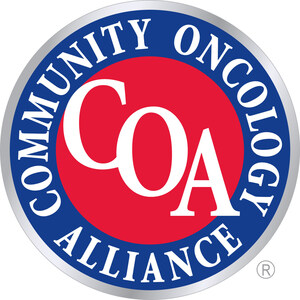Sequestration Cuts Threaten Seniors' Cancer Care While Increasing Medicare Costs
Just-Released Survey of Oncology Providers Shows Sequestration Effects on Senior Cancer Patients, Jobs, and Nation's Cancer Care Delivery System
WASHINGTON, May 9, 2013 /PRNewswire/ -- The Community Oncology Alliance (COA), a non-profit organization dedicated to preserving and fostering community cancer care, announced today the results of a national survey of oncology providers on the impact of the sequester cut to Medicare payments for cancer drugs and services that took effect April 1, 2013. This survey revealed that the 2% sequester cut has inordinately impacted community oncology practices because it is a payment cut to the underlying cost of cancer drugs. This cut places many of these drugs "under water" — meaning that the reimbursement by Medicare is less than the purchase price of the drug.
The majority of cancer patients are treated in office-based community oncology practices, where 69% of practices surveyed reported that patient treatment and/or operational changes already have been made due to the sequester cut to cancer drugs. These changes include:
- 49% of practices forced to send Medicare patients elsewhere for treatment
- 62% of practices reported they will be forced to send Medicare patients elsewhere for treatment if the sequester cut stays in place through July 31, 2013
- 21% of practices reported they are laying off staff
- 38% of practices expect to lay off staff if the sequester cut remains in place through July 31, 2013
- 14% of practices report opening or resuming discussions with hospitals to be acquired or form a professional service agreement
- 20% of practices will open or resume such discussions if the sequester cut remains in place through July 31, 2103
Based on the survey, and a study conducted by Milliman, an independent actuarial and consulting firm, on the cost differential between cancer care delivered in the practice versus hospital setting, the sequester cut will cost Medicare, and add to the deficit, an estimated $450-600 million annualized due to the shift to the more expensive hospital setting. This estimate does not include the increased cost to seniors when their treatment is provided in the hospital setting.
"We are now seeing the cascading effects of sequestration," said Mark Thompson, M.D., COA president and an oncologist at the Zangmeister Center, Columbus, Ohio. "Many practices are now sending their Medicare patients to hospitals for chemotherapy while others are laying off staff. Practices are so financially threatened that discussions of merging with a hospital — despite the increase in cost of care to the patients and the system — are being reopened."
Medicare reimbursement cuts to cancer care have adversely affected the cancer care delivery system over the past 4-5 years. Since 2008, more than 1,200 community cancer practices have closed, consolidated, or reported financial problems, resulting in patient access issues and increased Medicare costs by forcing patients into more costly settings. When community cancer clinics are forced to close their doors, access to cancer care is compromised for cancer patients, especially vulnerable seniors covered by Medicare.
"Congress has to put aside politics and immediately address this crisis to seniors battling cancer," said Ted Okon, executive director of COA. "Fixing the flight delays pales in comparison to the importance of stopping the irrational sequester cut to cancer drugs. Thankfully, Congressman Sessions and 123 House colleagues have written a letter to Medicare questioning these cuts and Congresswoman Ellmers has a bill, H.R. 1416, that would stop these destructive cuts."
The survey polled 326 cancer care facilities. These facilities account for 1,650 oncologists who collectively see 728,721 Medicare patients annually. For full survey results, go to www.CommunityOncology.org.
About Community Oncology Alliance (COA)
Celebrating its 10th anniversary during 2013, the Community Oncology Alliance (COA) is a non-profit organization dedicated solely to community cancer care, where four out of five Americans with cancer are treated. Since its formation, COA has helped community cancer clinics navigate an increasingly hostile environment by working together to become more efficient, advocating for their patients, and proactively providing solutions to the Congress and policy makers. COA members have testified before both chambers of Congress, authored cancer care demonstration projects, and been instrumental in the passage of oral cancer drug parity legislation, among many other initiatives. COA is leading a multi-stakeholder group that is developing and implementing an Oncology Medical Home cancer care model and is advancing payment reform for cancer care. More information can be found at www.CommunityOncology.org.
The COA Patient Advocacy Network (CPAN) was created in 2010 to advocate for access to local affordable care for all cancer patients. More information can be found at www.COAadvocacy.org.
SOURCE Community Oncology Alliance
WANT YOUR COMPANY'S NEWS FEATURED ON PRNEWSWIRE.COM?
Newsrooms &
Influencers
Digital Media
Outlets
Journalists
Opted In





Share this article